By RUNVAN®
How to prepare for rainy day runs
It’s no secret – Vancouver is known for its wet and rainy weather, but that shouldn’t stop you from experiencing one of the most beautiful running cities in the world year-round. This city still sees tons of runners on the streets during the rainy season, and there’s no reason why you shouldn’t join them!
Check out these tips and be prepared for your next rainy weather run or race.
1. Be smart about your layers.
You’ll hear this from everyone – if it’s cold and wet out, dress in layers but don’t overdress! The more layers you have on, the more wet, heavy clothing you’ll have to run with.
Go for a moisture-wicking technical base layer, which will pull sweat and rain away from your skin to prevent chafing and blisters. On top, you’ll want a lightweight wind and water resistant jacket. This will not necessarily keep all the rain out, but they will help keep your core temperature up and hold in body heat. Pair them with compression shorts or pants, which are also less likely to chafe. A hat or glasses can also help to keep rain out of your eyes.
2. Wear bright colours.
To stay safe on the roads, pick gear with brighter colours and reflective strips. We’re all familiar with the dark clouds that roll over the city when it rains, and this makes it more difficult for others to see you. By wearing bright or neon colours, drivers have more visibility and will be able to see you coming.
3. Bring extra socks.
If you can, carry an extra pair of socks with you – especially during a rainy race day. A dry pair of socks will make a huge difference, and is more likely to prevent blisters. This is especially helpful if it stops raining mid-run. If it’s not too cold, thinner socks don’t absorb as much water and can help with comfort.
Related article: What to expect from your first running race
4. Seal your electronics.
No one wants their electronics getting damaged from the rain, and keeping them in a plastic ziplock or waterproof bag is a surefire way to keep them safe.
5. Be extra cautious.
Rain makes the roads extra slippery, so it’s important to make sure your shoes have enough grip to prevent slipping. Take smaller and quicker steps, and pay attention to your footing to try to avoid as many large puddles as you can. Your modified strides will reduce the amount of time you spend on the wet surfaces, and decrease your risk of slipping.
The key to preparing for a rainy day run is recognizing that you’re going to get wet. Stay warm and safe, and remember to change out of your wet clothes as soon as you finish your run!


Trackbacks/Pingbacks